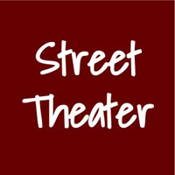
Explore this Show
Overview
Synopsis
In the early morning hours of June 28, 1969, the New York Police Department attempted to conduct a raid on the Stonewall Inn, a well-known gay bar in Greenwich Village. Many such raids had been conducted at other gay bars in the city. But unexpectedly, the patrons of the Stonewall fought back. Playwright Doric Wilson was there.
In Street Theater, Wilson assembles a cast of characters inspired by his own experience. A variety of patrons walk and linger along Christopher Street by the Stonewall Inn. There is Murfino, the tough-guy bar owner who is connected with the Mafia and regularly pays off the cops so they leave his establishment alone. Jack is a leather-clad, Harley-riding gay man, intimidating to look at but friendly and welcoming under the tough exterior. His close friend C.B., a butch lesbian, cares both for his motorcycle as well as for the young people that find their way to Greenwich, from flower child Heather to innocent Timothy. Ceil and Boom Boom are the local drag queens that inspire drama all around them, while various young gay men wander along the street. Rounding out the characters are two undercover cops, out to eliminate homosexuality. As these characters interact with each other--and the audience--Wilson creates an accurate and moving account of the tensions leading up to the Stonewall Riots, which sparked the beginnings of the Gay Pride Movement.
Show Information
- Book
- Doric Wilson
- Category
- Play
- Age Guidance
- Mature Audiences (M)
- Number of Acts
- 2
- First Produced
- 1982
- Genres
- Drama, Historical/Biographical
- Settings
- Unit/Single Set, Contemporary
- Time & Place
- Greenwich Village, June 1969, New York City
- Cast Size
- medium
- Orchestra Size
- None
- Dancing
- None
- Licensor
- See CONTEXT AND/OR LINKS TAB
- Ideal For
- College/University, Community Theatre, Diverse Cast, Mature Audiences, Mostly Male Cast, Professional Theatre, Regional Theatre, Includes Adult, Young Adult, Late Teen Characters, Medium Cast
Context
Plot
Characters
| Name | Part Size | Gender | Vocal Part |
|---|---|---|---|
|
Lead |
Male |
Non-singer |
|
|
Lead |
Female |
Non-singer |
|
|
Lead |
Male |
Non-singer |
|
|
Lead |
Male |
Non-singer |
|
|
Supporting |
Female |
Non-singer |
|
|
Supporting |
Male |
Non-singer |
|
|
Supporting |
Male |
Non-singer |
|
|
Supporting |
Male |
Non-singer |
|
|
Supporting |
Male |
Non-singer |
|
|
Supporting |
Male |
Non-singer |
|
|
Supporting |
Male |
Non-singer |
|
|
Supporting |
Male |
Non-singer |
|
|
Supporting |
Male |
Non-singer |
Songs
A song with an asterisk (*) before the title indicates a dance number; a character listed in a song with an asterisk (*) by the character's name indicates that the character exclusively serves as a dancer in this song, which is sung by other characters.
Monologues
Scenes
Key Terms
The imaginary wall between an audience and actors. To “break the fourth wall” means that actors acknowledge that the audience is there.
The accepted generic term for the LGBTQ+ theatre movement.
Videos
Quizzes
Themes, Symbols & Motifs
Sorry! We do not currently have learning modules for this guide.
Quote Analysis
Sorry! We do not currently have learning modules for this guide.
